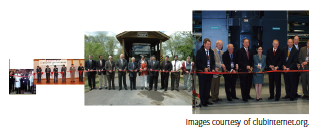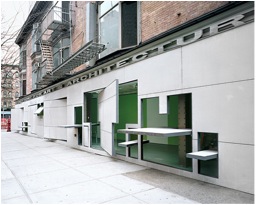By Anne Knight Weber

THINK YOU UNDERSTAND LIGHTING? DON’T LIKE AMBIGUITY? DON’T TRY THIS AT HOME!
Recipe to change your perceptions:
One square room
Four mirrors mounted in the center of each of the four walls
Four tripods with lights beaming in various strategic directions
Museum of Contemporary Art goers
When I decide to step away, the imaginary world created by Olafur Eliasson’s set up of lights and mirrors disappears right along with me. My image in the mirror disappears for what feels like forever. Will I decide to come back to stand there again and gaze into a mirror to take myself in, or be taken in, by space and time and light? Who will see me there? As the saying goes, I can’t dip my toe in the same river twice.
An electrical cord trails irreverently away from each of four spotlights set high atop a tripod. Look, Eliasson seems to be saying, “No magic here, just an ordinary an electric lamp powered by a cord.” Yet, each light setting in the room plays endlessly engaging games with my notion of my head. Am I the subject of the lighting? Or alternatively, am I imagining myself the one who will use these lights to create an image? Or is another museum visitor the one being observed by me, who is both an observer and part of the scenario? If I stand next to this tripod, does what I experience have to do with where I look? Or is my experience about where I stand in relation to the pool of light?
Each of Olafur Eliasson’s four staged locations in a square room has the exact same deceptively simple ingredients: a tripod holding a spotlight , a round circle of pooled light cast strategically on the wall, the floor or at a mirror, a rectangular mirror and of course, reflections in the mirror. Despite the identical elements, each setting is organized differently, with a different stated goal: observer, spectator, visitor and user. Yet none of the four sets is strictly for one to just observe, or only to spectate, or merely to visit or only to use the space in a square room. Not one of the titles fits one of the areas of the square room precisely for only the one stated goal.
My first move is to stand smack inside the center of a pool of light cast on the floor from a tripod above me. I look around self-consciously. Phew, no one is looking at me, despite the fact I stand in center stage lighting. I can’t see myself and no camera or audience of any kind is aware of me there in the pool of light. I am invisible in a spotlight. I have nothing to do but spy on other museum goers’ interacting with light, space and time. So, I see a young woman enter the exhibit room in the mirror across the room from me. She is not aware I am watching her. I am like a man in a submarine looking through a periscope. I see her image in the mirror, the image bounces off the mirror as through a periscope mirror so that I see her without her being aware of being watched in the mirror. I am at one remove from my subject: a young woman entering the exhibit room. All at once I am using the light by standing in the pool, observing that I am not being watched, being spectator to another visitor and visiting an exhibit.







